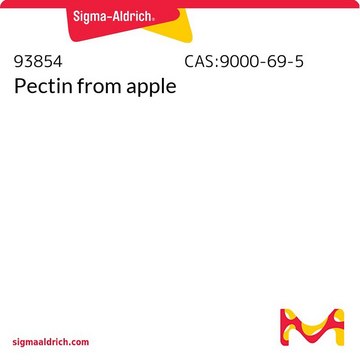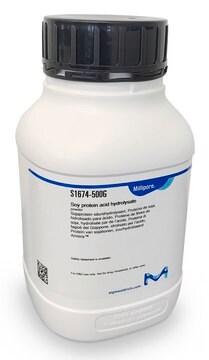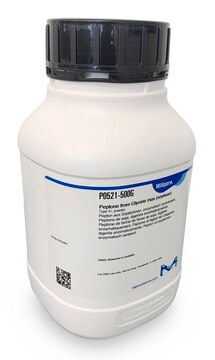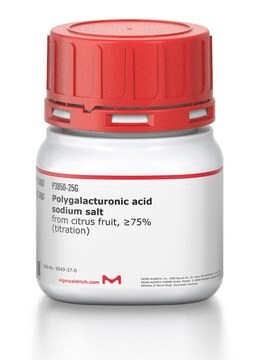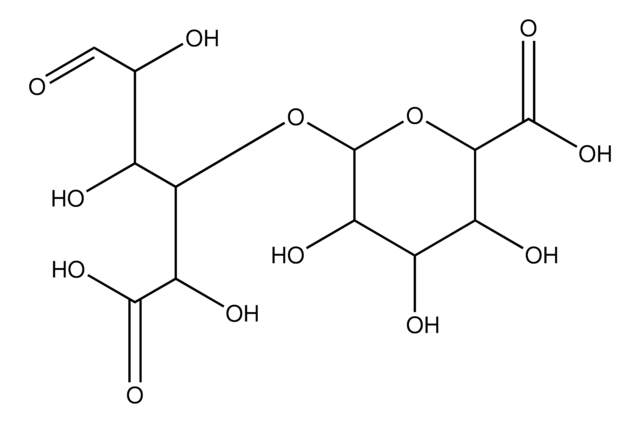P9135
Pectin from citrus peel
Galacturonic acid ≥74.0 % (dried basis)
Synonim(y):
Poly-D-galacturonic acid methyl ester
Zaloguj sięWyświetlanie cen organizacyjnych i kontraktowych
About This Item
Polecane produkty
pochodzenie biologiczne
citrus (peels)
Formularz
powder
skład
Galacturonic acid, ≥74.0% (dried basis)
zanieczyszczenia
≤10% Moisture
kolor
light brown
temp. przechowywania
room temp
Szukasz podobnych produktów? Odwiedź Przewodnik dotyczący porównywania produktów
Opis ogólny
Pectin is a polysaccharide is rich in galacturonic acid and possesses a complex structure and function.
Zastosowanie
Pectin from citrus peel has been used:
- in the comparative study of physicochemical, rheological and gelling properties of pectin among different extraction method
- in starch suspension for measuring in vitro starch digestibility
- to measure pectinase activity
- in the production of pectinase on solid medium
Działania biochem./fizjol.
Pectin is essential for plant development including growth, morphological changes and immunity. It serves as a stabilizing polymer and is useful in food and speciality products.
Pectin, a heterosaccharide component of terrestrial plant cell walls, is used as a substrate to identify, differentiate and characterized pectinase(s). Pectin is used to study its degradation by pectinolytic bacteria.
Inne uwagi
To gain a comprehensive understanding of our extensive range of Polysaccharides for your research, we encourage you to visit our Carbohydrates Category page.
Ta strona może zawierać tekst przetłumaczony maszynowo.
Kod klasy składowania
11 - Combustible Solids
Klasa zagrożenia wodnego (WGK)
nwg
Temperatura zapłonu (°F)
Not applicable
Temperatura zapłonu (°C)
Not applicable
Środki ochrony indywidualnej
Eyeshields, Gloves, type N95 (US)
Wybierz jedną z najnowszych wersji:
Masz już ten produkt?
Dokumenty związane z niedawno zakupionymi produktami zostały zamieszczone w Bibliotece dokumentów.
Klienci oglądali również te produkty
Optimization study of citrus wastes saccharification by dilute acid hydrolysis
Talebnia F, et al.
BioResources, 3(1), 108-122 (2012)
Overexpression of the plg1 gene encoding pectin lyase in Penicillium griseoroseum
Cardoso PG, et al.
Journal of Industrial Microbiology & Biotechnology, 35(3), 159-166 (2008)
Extraction of pectin from navel orange peel assisted by ultra-high pressure, microwave or traditional heating: A comparison
Guo X, et al.
Carbohydrate Polymers, 88(2), 441-448 (2012)
Influence of non-starch polysaccharides on the in vitro digestibility and viscosity of starch suspensions
Sasaki Tomoko and Kohyama Kaoru
Food Chemistry, 133(4), 1420-1426 (2012)
Wenjun Wang et al.
Ultrasonics sonochemistry, 70, 105322-105322 (2020-09-10)
In this study, modified citrus pectin treated with a combination of microfluidization and ultrasonication was compared to the original and ultrasonication treated pectin on hydrodynamic diameter, molecular weight, polydispersity, zeta potential, apparent viscosity, Fourier-transform infrared spectroscopy (FTIR), 2,2-diphenyl-1-picryl hydrazyl (DPPH)
Nasz zespół naukowców ma doświadczenie we wszystkich obszarach badań, w tym w naukach przyrodniczych, materiałoznawstwie, syntezie chemicznej, chromatografii, analityce i wielu innych dziedzinach.
Skontaktuj się z zespołem ds. pomocy technicznej